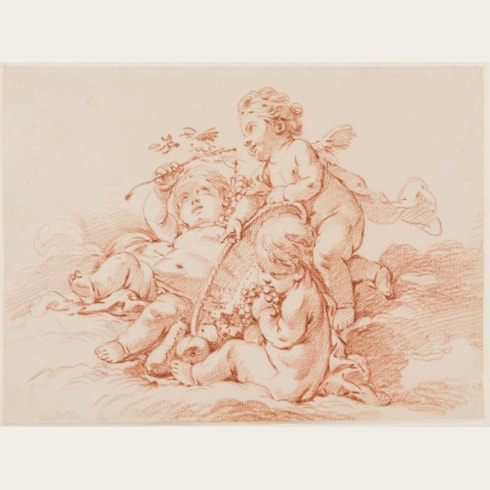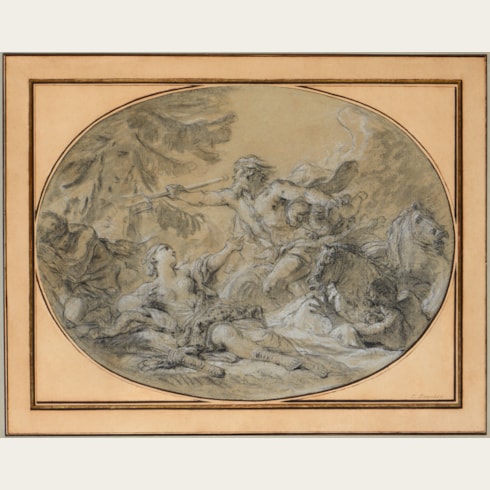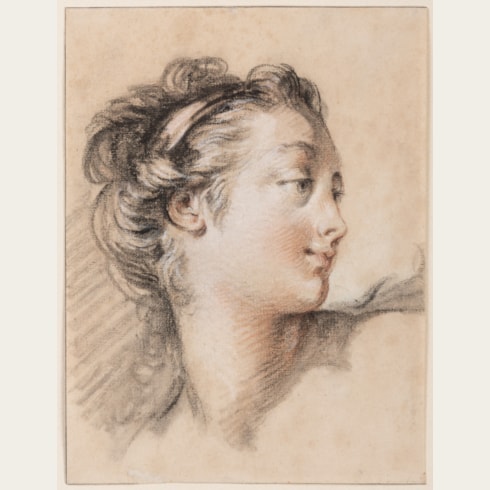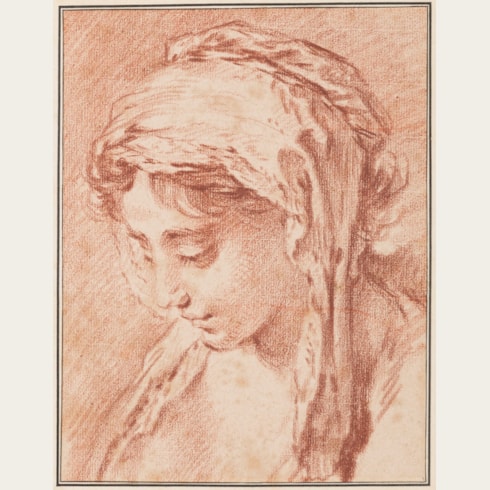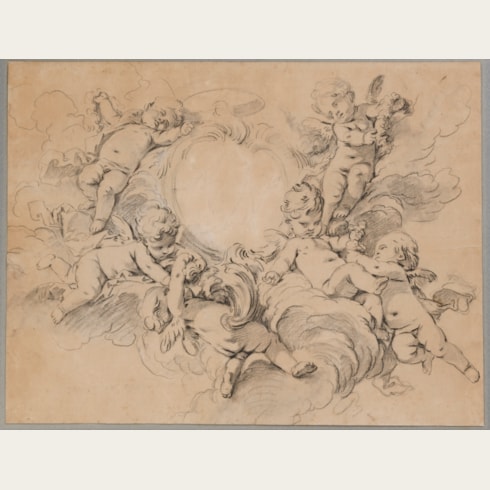François BOUCHER
(Paris 1703 - Paris 1770)
Study of a Male Nude Holding a Hammer Above his Head
310 x 189 mm. (12 1/4 x 7 3/8 in.)
A number of drawings of male nudes by Boucher, however, were not done as teaching exercises but as preparatory studies for paintings. As Alastair Laing has noted of this drawing, ‘[It] is a genuine study for a painting, rather than a derivative from a painting, done for collectors.’ The drawing may be related to an important painting by the artist; the Venus at the Forge of Vulcan, dated 1747, in the Louvre. A monochrome oil sketch for the composition is in the Louvre, while a drawing for a different forger in the painting, executed in black chalk, is in the Musée Sainte-Croix in Poitiers. A study for the Cupid with arrows and a dove may have been made after the figure in the painting, as a drawing for a collector, rather than as a preparatory study for it. No other preparatory drawings related to the painting of Venus at the Forge of Vulcan are known.
The standing figure in the present sheet was later reused in a more ambitious composition of the subject of Venus at the Forge of Vulcan, designed by Boucher for a tapestry woven at Beauvais between 1754 and 1756, for which a grisaille sketch is in the Louvre.
To judge by his distinctively rugged appearance, the model for both of these drawings seems to be Jean-François Deschamps, a popular model at the Académie whom Boucher favoured for drawings and paintings of the male nude from around 1740 onwards. Boucher’s contemporary, the writer Claude-Henri Watelet, in his posthumously published Dictionnaire des beaux-arts, noted that ‘sometimes Deschamps was the ever-youthful Mercury, sometimes the terrible Mars, sometimes Neptune, Pluto, Jupiter…There was nothing about him, including his head, that could not sometimes be recognised, and one was astonished to see his somewhat Bacchic face become that of a hero or a God.’ Among stylistically comparable red chalk drawings of male nudes by Boucher, also posed by Deschamps, are two studies in a Swiss private collection.
Appointed a professor at the Académie Royale in 1735, Boucher painted numerous easel pictures – pastoral landscapes, religious and mythological subjects, genre scenes, chinoiseries and portraits – for private clients in France, Sweden, Denmark, Germany and Poland, while also producing several tapestry cartoons for the Beauvais and Gobelins manufactories, where he succeeded Jean-Baptiste Oudry as inspecteur des ouvrages in 1755. He designed stage sets and costumes for the Opéra and the Opéra-Comique in the 1740s and created designs for Vincennes and later Sèvres porcelain throughout the 1750s and early 1760s. In 1765 Boucher was named premier peintre du roi, or First Painter to the King, and also appointed director of the Académie Royale. In 1770 he died at his lodgings in the Louvre and was buried in the church of Saint-Germain l’Auxerrois. Among his pupils were Jean-Baptiste Deshays and Pierre-Antoine Baudouin, both of whom became his sons-in-law and predeceased him, as well as Jean-Honoré Fragonard, Jean-Baptiste Le Prince and Gabriel-Jacques de Saint-Aubin.
A gifted draughtsman, François Boucher was as prolific as he was talented, and claimed to have produced ten thousand drawings over a career that lasted some fifty years. He was, in fact, perhaps the most prolific French draughtsman of the eighteenth century, and his drawn oeuvre includes pastoral scenes, nudes, religious, historical and mythological subjects, book illustrations, chinoiseries, landscapes, genre scenes, studies of children and heads, as well as designs for tapestries, porcelain and fountains. Although most of his drawings were preparatory studies for his paintings, Boucher also produced finished drawings as independent works, often adapting and elaborating a head or figure from one of his paintings. While his preference was for black, red, and (particularly in his later years) a dark brown chalk, he also made highly finished drawings in pastel and, at times, drew on coloured paper. As Pierre Rosenberg has succinctly noted, ‘Boucher’s love of drawing never waned with time and success. Admittedly, drawing was kept in its proper place, as a vital link between the conception or the idea of a work or composition, and its realization, its metamorphosis into a painting…To quote Mariette, Boucher “was a born painter”, but he placed great emphasis on drawing throughout his entire career.’ Boucher’s drawings were avidly collected in his lifetime by such connoisseurs as Barthelémy-Augustin Blondel d’Azaincourt, Paul Randon de Boisset, Pierre-Jacques-Onésyme Bergeret de Grancourt, Gilbert Paignon-Dijonval, Jean-Claude Gaspard de Sireuil, Count Carl Gustaf Tessin, and many others.
Boucher's drawn oeuvre includes all manner of subjects, including pastoral scenes, nudes, religious, historical and mythological subjects, book illustrations, chinoiseries, landscapes, nudes, genre scenes, studies of children and heads, as well as designs for tapestries, porcelain and fountains. He produced many finished drawings as independent works, often adapting and elaborating a head or figure from one of his paintings. While his preference was for black, red, and (particularly in his later years) brown chalk, Boucher also made highly finished drawings in pastel and, at times, drew on coloured paper. A large number of his drawings were finished works for collectors and the art market, and many were engraved and reproduced in considerable numbers – often making use of new printmaking techniques that allowed chalk drawings to be reproduced with a high degree of verisimilitude - by such printmakers as Louis-Marin Bonnet, Gilles Demarteau or Gabriel Huquier. His drawings were greatly admired, and while many were preparatory studies for his paintings, others were produced as finished works of art, to be sold to collectors or reproduced by engravers. Indeed, Boucher’s popularity as a draughtsman owes much to the fact that many of his drawings were reproduced and widely distributed as engravings.
Provenance
Hazlitt, Gooden & Fox, London, in 1988
Anonymous sale, New York, Sotheby’s, 8 January 1991, lot 170
Librairie Michel Descours, Lyon, in 1996
Saretta Barnet, New York.
Literature
Exhibition







